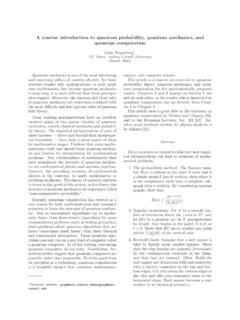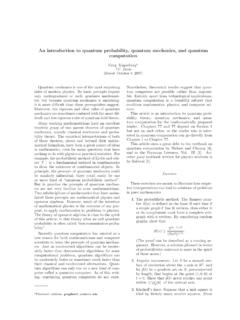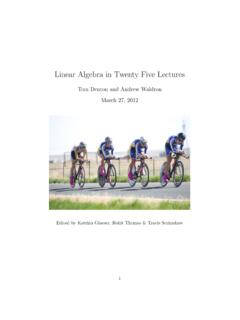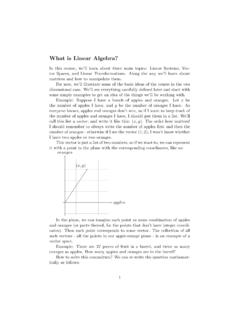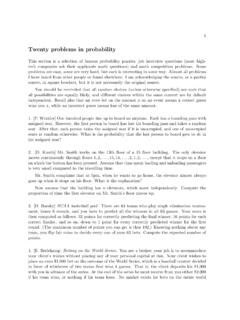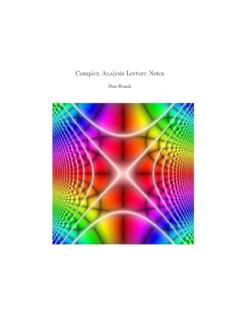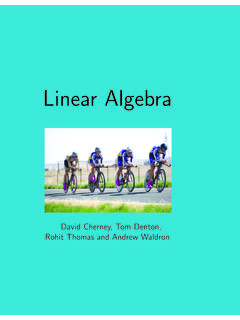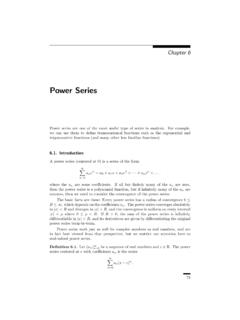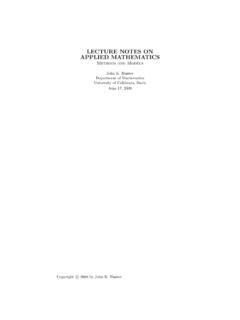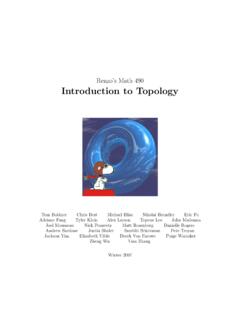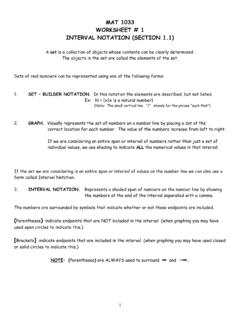Transcription of Problem Set 2: Solutions Math 201A Fall 2016 Problem 1 ...
1 Problem Set 2: SolutionsMath 201A:Fall 2016 Problem 1.(a) Prove that a closed subset of a complete metric spaceis complete. (b) Prove that a closed subset of a compact metric space iscompact. (c) Prove that a compact subset of a metric space is closed (a) IfF Xis closed and (xn) is a Cauchy sequence inF, then (xn)is Cauchy inXandxn xfor somex XsinceXis complete. Thenx FsinceFis closed , soFis complete. (b) Suppose thatF XwhereFis closed andXis compact. If (xn)is a sequence inF, then there is a subsequence (xnk) that convergestox XsinceXis compact. Thenx FsinceFis closed , soFiscompact. Alternatively, If{G X: I}is an open cover ofF,then{G : I} Fcis an open cover ofX. SinceXis compact,there is a finite subcover ofXwhich also coversF, soFis compact.
2 (c) LetK Xbe compact. If (xn) is a convergent sequence inKwithlimitx X, then every subsequence of (xn) converges tox. SinceKiscompact, some subsequence of (xn) converges to a limit inK, sox KandKis closed . Suppose thatKis not bounded, and letx1 K. Then for everyr >0there existsx Ksuch thatd(x1,x) r. Choose a sequence (xn) inKas follows. Pickx2 Ksuch thatd(x1,x2) 1. Given{x1,x2,..,xn},pickxn+1 Ksuch thatd(x1,xn+1) 1 + max1 k nd(x1,xk).By the triangle inequality,d(xk,xn+1) d(x1,xn+1) d(x1,xk) 1for every 1 k follows thatd(xm,xn) 1 for everym6=n, so (xn) has no Cauchysubsequences, and therefore no convergent subsequences, soKis a subset of a metric spaceXwith closure A. Definethe interiorA and boundary AofAbyA = {G A:Gis open}, A= A\A.
3 (a) Why isA open and Aclosed?(b) Prove thatX\ A= (X\A) .(c) Prove thatAis closed if and only if A A, andAis open if and onlyif A Ac.(d) IfAis open, does it follow that ( A) =A?Solution (a) A union of open sets is open soA is open, and an intersection ofclosed sets is closed so Aand A= A (A )care closed . (b) Note thatx A if and onlyB (x) Afor some >0. Ifx Ac,thenB (x) Acfor some >0 since Acis open. Since A A, wehave Ac Ac, soB (x) Ac, meaning thatx (Ac) . It follows that Ac (Ac) . For the reverse inclusion, note that ifx (Ac) , then thereexists >0 such thatB (x) Ac, soxis not the limit of any sequenceinA, meaning thatx Ac. It follows that (Ac) Ac, so (Ac) = Ac. (c) IfAis closed , then A=Aso A=A (A )c A. For the converse,note that sinceA A A, we have A= ( A A ) ( A (A )c) =A A A, then it follows that A A, soA= A, meaning thatAisclosed.
4 (d) This is not true in general. For example, defineA R2byA={(x,y) :x2+y2<1}\{(x,0) : 0 x <1}.ThenAis open, but ( A) ={(x,y) :x2+y2<1}6= a metric space with a dense subsetA Xsuch thatevery Cauchy sequence inAconverges inX. Prove thatXis Let (xn) be a Cauchy sequence inX. SinceAis dense inX, we canchoose a sequence (an) inAsuch thatd(xn,an) 0 asn . (Forexample, choosean Asuch thatd(xn,an)<1/n.) Given any >0, there existsM Nsuch thatd(xn,an)< /3 andd(xm,xn)< /3 for allm,n > M, sod(am,an) d(am,xm) +d(xm,xn) +d(xn,an)< ,which shows that (an) is a Cauchy sequence inA. It follows that (an)converges to somex X. Given any >0, there existsN Nsuch thatd(xn,an)< /2 andd(an,x)< /2 for alln > N, sod(xn,x) d(xn,an) +d(an,x)< ,which shows that (xn) converges toxand proves thatXis :X X Rbe the discrete metric on a setX,d(x,y) ={1 ifx6=y,0 ifx= are the compact subsets of the metric space (X,d)?}
5 Solution A subset ofXis compact if and only if it is finite. Every finite set is compact. IfF={x1,x2,..,xn} Xand{G X: I}is an open cover ofF, thenxk G kfor some k I, so{G 1,G 2,..,G n}is a finite subcover ofF. Alternatively, every sequence inFhas aconstant subsequence, which converges to a point inF. Conversely, ifF Xis infinite andGx={x}, then{Gx:x F}is an open cover ofFwith no finite subcover. Alternatively, ifFisinfinite, then there is a sequence (xn) inFwithxm6=xnfor allm6=n,sod(xm,xn) = 1 form6=n, and (xn) has no Cauchy or rough heuristic is that compact sets have many properties incommon with finite sets . For example, finite sets have the finite the Banach space of real sequences (xn) such thatxn 0 asn with the sup-norm (xn) = supn N|xn|.
6 Is the closedunit ballB={(xn) c0: (xn) 1}compact?Solution The closed unit ball inc0is not compact. For example, letek= ( nk) n=1 nk={1 ifn=k0 ifn6=kdenote the sequence whosekth term is one and whose other terms arezero. Thenek c0since limn nk= 0, andekbelongs to the closedunit ball inc0since ek = 1. However, ej ek = 1 for everyj6=k,so (ek) k=1has no Cauchy or convergent subsequences similar argument using the Riesz lemma shows that the closedunit ball in any infinite-dimensional normed space is not compact in the metric (or topological) spaceXis disconnected if there arenon-empty open setsU,V Xsuch thatX=U VandU V= . A spaceis connected if it is not disconnected. A spaceXis totally disconnected ifits only non-empty connected subsets are the singleton sets {x}withx X.}
7 (a) Show that the interval [0,1] is connected (in its standard metric topology).(b) Show that the setQof rational numbers is totally (a) Suppose for contradiction that [0,1] =U VwhereU,Varenonempty, disjoint open sets in [0,1]. We assume that 0 Uwithoutloss of generality. Leta= sup{x [0,1] : [0,x) U}. Since 0 UandUis open, wehave [0, ) Ufor some >0, so 0< a 1. If 0< b < a, then [0,b) Usince, by the definition of the supremum, there existsb < c < asuchthat [0,c) U. (It also follows that [0,a) = 0<b<a[0,b) U, so thesupremum is attained and, in fact,{x [0,1] : [0,x) U}= [0,a].) Ifa U, then (a ,a+ ) Ufor some >0, but then [0,a+ ) U,contradicting the definition ofa. On the other hand, ifa V, then(a ,a] Vfor some 0< < a, but then [0,b)6 Ufora < b a,also contradicting the definition ofa.]]]]]]]]
8 (b) LetA Qbe any subset of the rational numbers with at least twoelements. Choosex,y Awithx6=y. The irrational numbers aredense inR, so there existsz R\Qsuch thatx < z < y. LetU= ( ,z) A, V= (z, ) ,Vare open sets in the relative topology onA. Moreover,x U,y VsoU,Vare nonempty, andU V= ,U V=A. Itfollows thatQis totally {G R:Gcis countable orGc=R}.(a) Show thatTis a topology onR.(b) LetI= (0,1) with closure I= {F I:Fis closed }in this that I=R.(c) Is there a sequence (xn) such thatxn Iandxn 2 in this topology?(d) What part of your proof in Problem 5 of Set 1 fails in this example?Solution (a) The collection of closed setsC={F R:Fc T}in this topologyis given byC={F R:Fis countable orF=R}. The collectionCsatisfies the axioms for closed sets in a topologicalspace: (1) ,R C.
9 (2) The intersection of closed sets is closed , sinceeither every set isRand the intersection isR, or at least one setis countable and the intersection in countable, since any subset of acountable set is countable. (3) A finite union of closed sets is closed ,since a finite (or countable) union of countable sets is countable. Itfollows thatTis a topology onR(called the co-countable topology). (b) IfF Iis closed , thenFis uncountable, since (0,1) is uncountable,soF=Rand I=R. (c) Let (xn) n=1be a sequence in (0,1). ThenU=R\{xn:n N}isan open neighborhood of 2, butxn/ Ufor anyn N, so (xn) doesnot converge to 2. A similar argument applies to anyx / (0,1), so thesequential closure ofIis I= (0,1). (d) IfXis a topological space, then a neighborhood base ofx Xisa collection{U : A}of neighborhoods ofxsuch that for everyneighborhoodUofxthere exists AwithU U.
10 Thenxn xifand only if for every Athere existsN Nsuch thatxn U foralln > N. The proof that the sequential closure is equal to the closurefails for the co-countable topology onRbecausex Rdoes not havea countable neighborhood base. On the other hand, ifXis a metricspace, then{B1/n(x) :n N}is a countable neighborhood base of anyx the set of sequences whose terms are 0 or 1:S={(sk) k=1:sk= 0 orsk= 1}.(a) Use a diagonal argument to show thatSis uncountable.(b) Show thatShas the same cardinality as the power setP(N) of the (a) Letf:N S. Suppose thatf(n) =snwheresn= (skn) k=1, anddefinet= (tk) k=1 Sbytk={1 ifskk= 0,0 ifskk= everyk N, since the two sequences have differentkth terms. It follows that there is no map fromNontoS, soSisuncountably infinite.}

